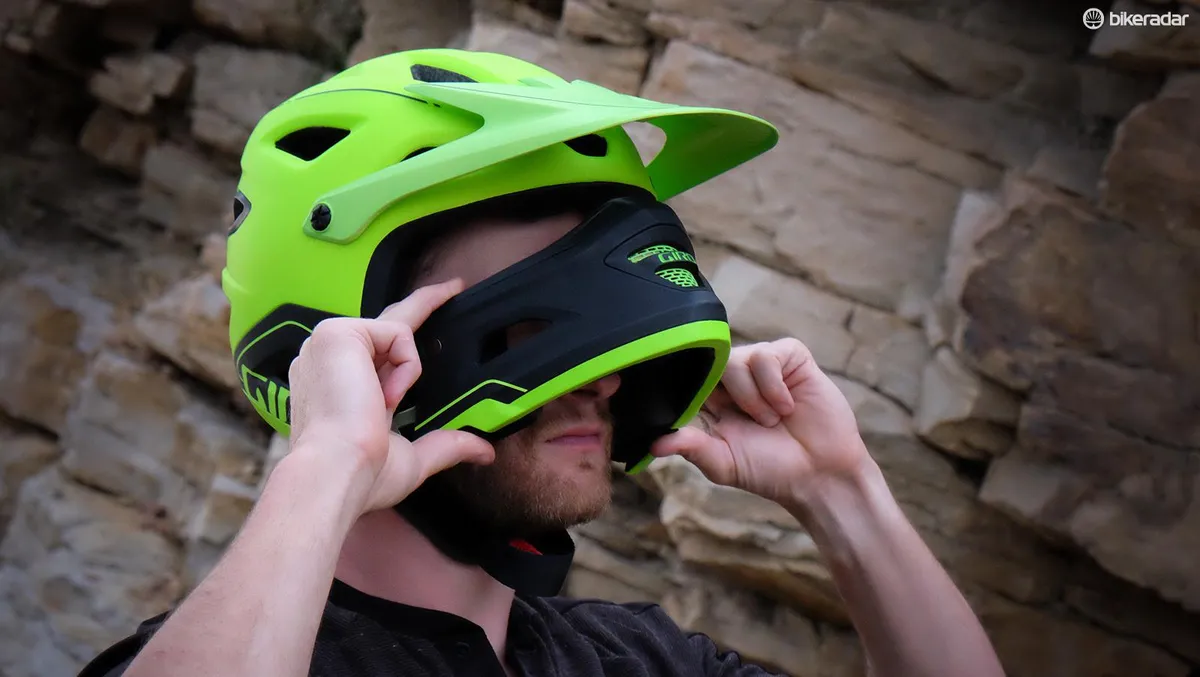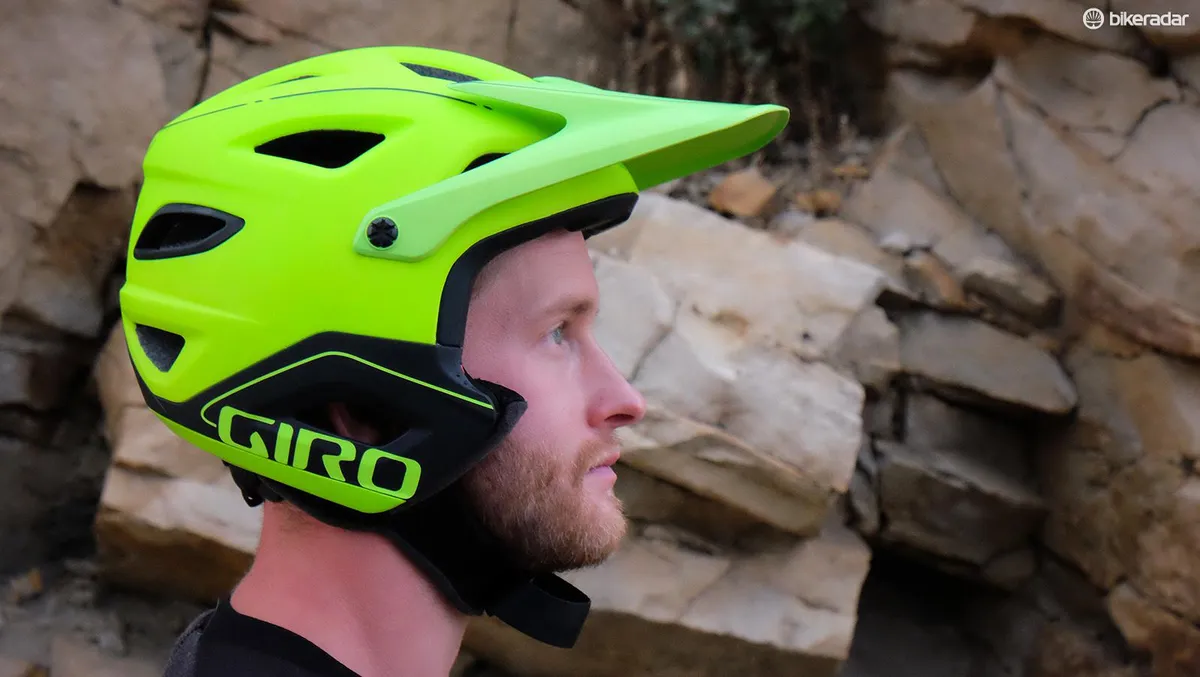Giro's Switchblade breaks from the traditional take on convertible full-face / half-shell helmets. The unique moto-trials look is certain to garner glances from fellow riders, but it's the helmet's safety ratings, useful features and ease of use that make this helmet a category leader.
Giro Switchblade MIPS details
- Certified to CPSC, EN-1078 and ASTM-1952-DH standards (with and without the chin bar)
- MIPS-equipped
- Roc Loc Air DH fit system
- 20 vents
- Offered in S, M and L sizes
- Pricing is £225 / US$250 /€299
Legacy name for a new lid

It was a bold move to resurrect the Switchblade name for this new convertible full-face helmet. The original Switchblade, introduced way back in 1998, wasn’t exactly a hit. Or rather, it did a poor job of taking them. The helmet was based around a cross-country shell and the chin bar was notoriously fragile, offering very little impact protection.
The market for convertible helmets didn’t really exist yet, either. Today’s enduro-bros were still riding with training wheels when it debuted.
The original Switchblade might not have been tough enough for downhill, but it gained a small following with trail riders who would watch a New World Disorder DVD, chug a Red Bull and then huck-to-flat off a rickety skinny they constructed from pallets. It was also popular with 50-year-old men who rode their Ellsworth Dares in Moab once a year.
It was a different time, to say the least.
The original Switchblade might not have been up to snuff, but the idea had merit. Giro was just thinking too far ahead of the curve.
While other companies entered the convertible helmet market, Giro took its time, learning from the shortcomings of others, refining its designs and focusing on making a new Switchblade that was a full-face first and a half-shell second.
“Without a doubt, this is the most complex helmet we’ve ever made,” said Dain Zaffke, Giro’s marketing director.
Full of features

Zaffke isn’t exaggerating. The new Switchblade is packed full of technology. First and foremost is the manner in which the chin bar attaches to the helmet. Giro’s system relies on a pair of metal guide bars and hooks that hold the chin bar in place.

Giro has devised a very clean, very user-friendly system. It took me a handful of fumbled attempts before it became second nature to accurately slot the guide bars into place and swing the chin bar down. Everything locks into place with a reassuring ‘click’ that leaves you feeling locked and loaded.
How to remove and install the Giro Switchblade face guard
In contrast to the attachment systems used on other convertible helmets, there’s no need to remove the helmet when transitioning from climbing to descending and back again.
Another key feature that distinguishes the Switchblade from its competitors is that it passes the rigorous ASTM downhill testing standard with and without the chin bar installed.
Also on the roster of safety elements is the MIPS system, designed to dissipate rotational forces in crashes. Like any good helmet, safety features are the primary design criteria, but Giro didn’t skip on creature comforts, either.
There are 20 vents that do a commendable job of moving air through the helmet. It won’t surprise many readers to learn that it’s not as well ventilated as a standard trail helmet, but it comes close.

The Switchblade ships with two visors. The POV Plus visor pivots up and out of the way to allow the wearer to place their goggles on the brow. The auxiliary visor lacks this indexed adjustment, but offers a GoPro-style mount for action cameras.
In spite of the mountain of tech packed into the Switchblade, Giro managed to keep it incredibly light. The in-mold construction helps keep the weight down to just 975g. This makes the Switchblade 205g lighter than the Cipher, Giro’s top-end full-face, which features a fiberglass shell. Even more impressive is the fact that it’s 75g lighter than the Bell Full 9, which uses a carbon fiber shell.
With this weight saving, why would anyone purchase a traditional full-face? Well, price is certainly the most significant factor. It’s more expensive than the Cipher and riders who are looking for a dedicated full-face helmet would be buying tech they don’t need.
Ride impressions

As a full-face, the Switchblade is fantastic. Giro’s Roc Loc Air DH fit system sits at the base of the skull and offers great retention.
The POV Plus visor provides three useful indexed positions and an easy place to stow your goggles between runs. The fixed position visor provides a relatively stable position for filming, though not quite as stable as the top helmet mount that Giro uses on the Montaro half-shell helmet. Although the true POV view of the under-visor mount is very nice.
As mentioned above, ventilation is good for a helmet of this category. The thick straps of the D-ring closure system were more noticeable during hot rides than the additional coverage. Given the intended use as a full-face helmet first and a trail helmet second, the Switchblade functions as expected.

Thanks to the Switchblade’s many vents, auditory feedback is the best of any full-face helmet I’ve worn. It’s also better than I expected when worn as a half shell.
With the chin bar removed, the Switchblade is apt to garner some sideways glances from fellow riders. Giro calls the style “full cut.” I’ll stay out of the style fray and focus solely on function. The byproduct of this moto-trials look is that you have small chin guard that is very easy to secure to your pack when climbing and a helmet that passes downhill testing standards in both configurations.
Giro might be a latecomer to the convertible-helmet market, but it's quite clear the company did its homework. Yes, the look is different. Is different good? That's up to you to decide. When it comes to safety, function and comfort, the Switchblade is the clear category leader.

